Exploration of Lichenes in the Mutis Mount Area, Noepesu Village, West Miomaffo District
on

Advances in Tropical Biodiversity and
Environmental Sciences
7(1): 13-21, February, 2023
e-ISSN:2622-0628
DOI: 10.24843/ATBES.2023.v07.i01.p03
Available online at: https://ojs.unud.ac.id/index.php/ATBES/article/view/96275
Exploration of Lichenes in the Mutis Mount Area, Noepesu Village, West Miomaffo District
Kamaluddin*, Emanuel M. Y. Hanoe, Vinsensia Ulia Rita Sila
Program Study of Educational Biology, Faculty of Education, Timor University Jl Kefamenanu KM.09, Sasi, Kefamenanu, Timor Tengah Utara,
Nusa Tenggara Timur, Indonesia - 85614
*Corresponding author: kamaluddinbio@gmail.com
Abstract. This study aims to explore and identify the types of Lichenes that exist at the Mutis Mount Area, Noepesu Village, West Miomaffo District, and the Biology Education Laboratory, University of Timor. This research was conducted for 6 months starting from May-October 2022. This research is descriptive qualitative research. Sampling used a purposive sampling method. The collected Lichenes were identified based on their characteristics using the determination key and then matched with the photo collection. Morphological observation of lichenes was conducted at the Biology Education Laboratory, University of Timor using a microscope. The result of observations and collections based on this research conducted in the Mutis Mount area found 29 species of Lichenes with 12 families, the species found were Septennium azureum, Parmotrema tinctorum, Parmotrema perlatum, Parmelia sulcate, Parmelia sp, Flavoparmelia afternoondians, Usnea hirta, Usnea sp 1, Pyxine subcinerea, Cryptothecia sp, Dirinaria sp, Lepraria Lobificans, Lepraria incana, Lepraria sp 1, Hydropunctaria maura, Candelariella sp, Arthonia ilicina, Arthonia Radiata, Arthonia Clemens, Graphis Scipta, Graphis sp1, Graphis sp2, Graphis sp3, Graphis sp4, Graphis sp5, Graphis sp6, Ramalina farinaceae, Cryptothechia striata, and Bacidia insularis. Lichenes were found in soil, weathered wood, tree trunks, and rocks with thallus morphology, namely Crustose, Foliose, Fructicose, and Squamulose.
Keywords: Exploration; Lichenes; Mount Mutis; Noepesu Village
-
I. INTRODUCTION
Indonesia along with a number of other tropical countries such as Brazil, Zaire and Mexico, is a country that has mega biodiversity. Biodiversity is the term used to describe the diversity of ecosystems and the variety and variability of animals, plants and microorganism in the world. It is estimated that 30% of plants and 90% of animals in Indonesia have not been completely recorded and scientifically documented [1].
Lichenes is an association between fungi and photosynthetic symbionts in the form of algae or cyanobacteria that form a stable and specific thallus structure. Association form lichenes tends to increase the ability of fungi or algae to survive in environmental conditions that are not suitable because its thallus structure. Physiology and the synthesis of lichenes chemical compounds is different from its constituent (fungi or algae) [2].
Lichenes are one of the plants that have not been studied much in Indonesia, when compared to countries such as North America and Thailand [3]. However, if studied more deeply, Lichenes play a very important role as guardians of ecosystem balance, pioneer plants, regulating water systems by preventing erosion, environmental bioindicators, raw materials for traditional medicines, sources of natural chemicals for pharmaceuticals, cancer drugs, raw materials for litmus paper. Furthermore, [4] stated that the benefits of lichenes for life are that they can be used as medicine such as Usnea filipandula (antibiotic), because they contain anti-cancer, then used as a flavor and aroma enhancer (Japanese cuisine). Rocela tinctoria which produces pigments that can be used as pH indicator litmus paper and lichenes can be used as bioindicators of environmental pollution because lichenes are very sensitive to pollution [4].
The lichenes thallus are gray or greenish-gray in color, yellow, orange or red with varied habitats. The body part
that is cellularly elongated are called hyphae, have a soredium and live as epiphytes [4]. Lichenes grow on rock surface, decaying logs, trees, and roofs in many forms. One of the factors that influence the shape of the thallus is the substrate where it is growth. Crutose type of thallus is the most common type because it is able to attach to various substrates [5].
Mount Mutis has a unique nature and important function, around 12,000 hectares of the area has been designated by the government as a nature reserve. Geographically, Mount Mutis is located at coordinates 9° 33′ 39.28″ S, 124° 13′ 47.95″ E. Its peak is at an altitude of 2,427 above sea level. This area is the wettest area on the island of Timor with five dry months and seven wet months. In November-March, this area receives strong winds accompanied by heavy rains. At the research location around Mount Mutis the average field temperature is 27.8°C with humidity around 58%, this is optimal for the growth of Lichenes in accordance with the statement of Gauslaa and Solhaug that the optimal temperature for Lichen growth is less than 40°C [6]. Noer further added that lichen likes places with a humidity range of 40-69% [7].
Based on the background above, this research aims to explore the types of Lichenes that exist in the foot of Mount Mutis, Noepesu Village, West Miomaffo District as an initial step in developing references to low plants in the Mount Mutis area. The results of this study are expected to be used as a reference regarding the diversity of Lichenes plants in the Mount Mutis Region, West Miomaffo.
-
II. RESEARCH METHODS
This research will be carried out in the Mount Mutis Area, Noepesu Village, West Miomaffo District, North Central Timor, and at the Biology Education Laboratory, Faculty of Education, Timor University. This research was carried out for 6 months starting from May-October 2022. This research used an exploratory method with a descriptive approach, that is conducted by conducting direct observations of pioneer plants in the field. Explorative research can be interpreted as an activity to explore the place that is used as the object of research and collect as much data as possible regarding any plant samples found at the research location. Exploration was carried out at 3 research stations, namely station I, station II and station III. These three stations assigned at Purposive sampling.
This type of research is qualitative descriptive research. Sample taken by purposive sampling method [8]. A sampling that is not based on strata, random but based on certain considerations to suit the intended research objectives. The collected lichens were then identified based on their characteristics using a determination key
and matched with a collection of photographs. Lichenes morphological observations were carried out in the Biology Education Laboratory at Timor University using a loop and a microscope.
-
III. RESULTS AND DISCUSSION
The results of observations and collections based on research conducted at the foot of Mount Mutis found 29 species of lichen with 12 families. Lichens are found in soil, weathered wood, tree trunks and rocks. This study used 3 stations as sampling locations, where station I was an area adjacent to residential areas, rice fields and rocky cliffs. Station II is located on the edge of the river and in an area with lots of trees. Station III is a forest area until the village community of Noepesu settlement. The types of Lichenes found can be seen in Table 1.
Based on exploration results in the Mount Mutis Area, 29 species of Lichenes were found from 12 families, namely Collemataceae, Parmeliaceae, Physciaceae, Aroniacheae, Stereocaulaceae, Verrucariaceae, Candelariaceae, Arthoniaceae, Graphidaceae, Ramalinaceae, Arthoniaceae, and Bacidiaceae. The most common species found were the Graphidaceae and Parmeliaceae families with 7 species (Figure 1). The types of Lichenes thallus found consisted of Crustose, Foliose, Fructicose and Squamulose (Figure 2).
Number of Species
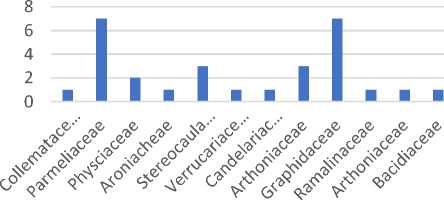
Figure 1. Number of species from the 12 families found
At the three observation stations, the most common Lichenes species were found at stations II and III because these areas have a high density of trees, especially at station II which is a riverside area with rocky and tree habitats which are spot for lichens. Lichen growth substrate (Lichenes) is almost entirely found in the bark of tree trunks, but there are also some on the rocks surface. Lichenes dominantly grow on the bark of tree trunks due to their nature which likes damp and cold places, as according [9]. Which states that there are many types of Lichenes that grow on trees because its high temperatures and tree trunks are moist so very easy for Lichenes to grow. well. [10] which states that Lichenes grow well in
mountainous areas which have a relatively large number of trees that can be used as a substrate on bark, branches and rock surfaces.
Thallus Type
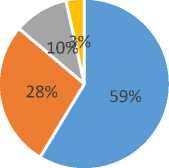
-
■ Crustose ■ Foliose ■ Fructicose ■ Squamulose
Figure 2. Types of Thallus Lichenes in Research Locations
The Parmeliaceae and Graphidaceae families are the families with is most frequently found, at least 7 species. The Parmeliaceae family found at the study site were Parmotrema tinctorum, Parmotrema perlatum, Parmelia sulcate, Parmelia sp, Flavoparmelia soredians, Usnea hirta, and Usnea sp 1. And for Graphidaceae the species found at the research site were Graphis Scipta, Graphis sp1, Graphis sp2, Graphis sp3, Graphics sp4, Graphics sp5, and Graphics sp6.
The Parmeliaceae family has a thallus with a foliose shape, morphology generally shaped like a leaf with a gray-green color. Parmeliaceae is a type of lichens foliose with a thallus structure that is easy to recognize and spread wide. The Parmeliaceae structure continues to form the upper cortex in the form of the medulla and parts under the cortex such as Rhizines. Rhizines in Parmeliaceae are useful in absorption of food required by lichens, so when the environmental condition begins to be polluted, lichens can still alive [11]. The thallus in the Graphidaceae family is form a small line attached to the the top of the substrate. The Graphidaceae family has a shaped morphological linear structure, irregular and elongate ascorcarps like hieroglyphs. Type example of Graphidaceae is Graphis sp. has a crustose type, and morphological structure composed of the outer cortex, medulla area and algae area [12].
Parmelia sp has a thallus morphology shaped like a green leaf and the thallus structure is more loosely attached to the substrate. Lichenes Parmeliaceae looks like a leaf, the color is green to greyish green, the thallus is shaped like a leaf or what is known as foliose. The Parmeliaceae family is the largest group of Lichenes foliose which has a specific and easily recognizable thallus shape. According to Kansri , the structure of Parmelia consists of an upper cortex, algae area, medulla, and a lower cortex in the form of rhizines. Rhizines function as a tool to absorb food for
Lichenes, so that Lichenes Parmelia can grow well even in a polluted environment [13].
The morphological characteristics of Graphidaceae have an elongate, linear, irregular and elongated ascocarp shape. [14] Graphidaceae has a crustose thallus type and can be used as an indicator of air pollution. [15] States that Graphidaceae is a group of crustose lichens which are commonly found in tropical and subtropical regions and consists of 79 genera. Furthermore, [16] graphidaceae is the second largest family in the lichen group with more than 1800 species.
Hasanuddin said that based on the morphology of the thallus, lichens (Lichenes) are divided into four types, namely Crustose, Foliose, Fructicose and Squamulose. The Crustose type has a thallus shaped like a crust (hard skin), small in size, flat, thin, and tightly attached to the substrate (tree bark, soil or rock) making it difficult to separate. The Foliose type has a thallus shaped like a leaf, flat, flat, wide, wavy, has many indentations resembling a wrinkled leaf rotating, differs on the upper and lower surfaces, lives and grows attached to trees and rocks. The Fructicose type has an upright thallus, a hanging shrub, having many branches such as hair, ribbons or ropes with fraying, living and growing hanging from tree branches, leaves or rocks. The Squamulose type has a thallus in the form of lobes resembling scales, these lobes are called Squamulose which generally have small sizes and overlap each other, also have a fruiting body structure called podetia [4].
Lichenes with the Crustose thallus type consist of 17 species namely Cryptothecia sp, Lepraria Lobificans, Lepraria incana, Lepraria sp 1, Hydropunctaria maura, Arthonia ilicina, Arthonia Radiata, Arthonia Clemens, Graphis Scipta, Graphis sp1, Graphis sp2, Graphis sp3, Graphis sp4, Graphis sp5, Graphis sp6, Cryptothechia striata, Bacidia insularis. Foliose thallus type consists of 6 species namely Leptongium azureum, Parmotrema tinctorum, Parmotrema perlatum, Parmelia sulcate, Parmelia sp, Flavoparmelia soredians, Pyxine subcinerea, Dirinaria sp. Lichenes with fructicose thallus type consist of 3 species namely Ramalina farinaceae, Usnea hirta, Usnea sp 1. And Lichenes with Squamolose thallus type consist of 1 species namely Candelariella sp.
The type of crustose thallus is found in Noepesu Village because this Morphological Type species tends to be more adaptive in its habitat and tends to live in locations or habitats that have extreme climates. This is because Lichenes form crustose attached tightly to the substrate and can survive in conditions of minimal water or dry land. As for the morphological types of foliose, fructicose and squamulose thallus, only a few were found because these types are less adaptive than the Crustose type. This is in line with [17], stating that the crustose thallus type is the
most resistant type of thallus compared to other types of thallus. Furthermore, [18] fruticose and foliose thallus forms are relatively intolerant of unsuitable habitats, so they are only found in certain environmental conditions. Lichenes with a foliose-shaped thallus have weak attachment to the substrate, so they are easily detached from the substrate [19,20].
-
IV. CONCLUSIONS
Lichenes found in the Mount Mutis area are 29 species consisting of 12 families, the families Parmeliaceae and Graphidaceae were the families with the most species found, namely 7 species each. Lichens are found in soil, weathered wood, tree trunks and rocks. The types of thallus morphology found were Crustose, Foliose, Fructicose and Squamulose.
ACKNOWLEDGMENT
The Research Team would like to thank the Timor University LPPM for providing funding support for this research activity. Acknowledgments to all parties who also provided moral support and energy so that this research was carried out as expected.
REFERENCES
-
[1] Hasan, M dan Ariyanti, N. S. 2004. Mengenal Bryophyta (Lumut) Taman Nasional Gunng Gede Pangrango. Balai Taman Nasional Gunung Gede Pangrango. Cibodas.
-
[2] Susilawati, P. R. 2017. Fruticose dan Foliose Lichen di Bukit Bibi, Taman Nasional Gunung Merapi. Jurnal Penelitian, 21(1): 12-21.
-
[3] Rindita. 2014. Analisis Populasi Liken Makro Epifitik Sebagai Bioindikator Kualitas Udara Di Kota Bogor. Skripsi: Institut Pertanian Bogor.
-
[4] Hasanuddin. 2014. Botani Tumbuhan Rendah. Banda Aceh: UIN Ar-Raniry.
-
[5] Campbell, N.A., J.B. Reece, L.G. Mitchell. 2012. Biologi, Jilid 2 Edisi ke delapan. Erlangga, Bogor: x, 404 hlm.
-
[6] Gauslaa, Y. and Solhaug, K.A. 1998. Hight-light Damage in Air-dry Thalli of Old Forest Lichen Lobaria Pulmonaria: Interaction of Irradiance, Exposure Duration and Hight Temperature. Journal of Experement Botani. 5 (4): 667-705.
-
[7] Noer, I.S. 2004. Bioindikator Sebagai Alat Untuk Menengarai Adanya Pencemaran Udara. Forum Komunikasi Lingkungan III. Bandung: Kamajongan.
-
[8] Roziaty, E. and Utari, R. T. 2017. Jenis dan Morfologi Lichen Fruticose di Kawasan Hutan Sekipan Desa Kalisoro Tawangmangu Karanganyar
Jawa Tengah. Proceeding Biology Education Conference, 14(1).
-
[9] Muslim dan Hasairin, A. 2018. Eksplorasi lichen pada tegakan pohon di area taman margasatwa (medan zoo) Simalingkar Medan Sumatera Utara. Jurnal Biosains, 4(3), 145-153.
-
[10] Wuryaningsih, S. 2007. Keanekaragaman Lichenes Corticolous pada Johar cassia siamea dan Palem Botol Hyophorbe lagenicaulis Sebagai Bioindikator Pencemaran Udara di Lingkungan Kampus Unipa. Jurnal Biologi, 1(1): 1–7.
-
[11] Hadiyati, M., Setyawati, R.T., Murkalina, 2013, Kandungan Sulfur dan Klorofil thallus lichen Parmelia sp. Dan Graphis sp. Pada Pohon Peneduh Jalan di Kecamatan Pontianak Utara, Universitas Tanjungpura, Pontianak.
-
[12] Devi S. 2019. Inventarisasi Lichenes (Lumut Kerak) di Taman Wisata Alam Danau Sicikeh-Cikeh Desa Lae Hole Kecamatan Parbuluan Kabupaten Dairi Sumatera Utara. Prodi Biologi Fakultas Sains dan Teknologi, Universitas Islam Negeri Sumatra Utara.
-
[13] Panjaitan, Desi Maria, Fitmawati dan Atria Martina. 2012. Keanekaragaman Lichen Sebagai Bioindikator Pencemaran Udara di Kota Pekanbaru Provinsi Riau. E-journal Unriau. 1(1): 1-17.
-
[14] Nurjanah, S., Anitasari, Y., Mubaidullah, S. and Bashri, A. 2013. Keragaman dan kemampuan lichen menyerap air sebagai bioindikator pencemaran udara di Kediri. Surakarta: Proceeding Biology Education Conference: Biology, Science, Environmental and Learning, 10(1).
-
[15] Hardini, J., Kasiamdari, R. S., Santosa., Purnomo. 2018. A New Species of Glyphisach. And Three New Records of Graphisadans (Graphidaceae) From Bali Island, Indonesia. Bangladesh J. Plant Taxon, 25(2): 159-166.
-
[16] Plata, E.R., Parnmen, S., Staiger, B., Mangold, A., Frisch, A., Weerakoon, G., Hernandez, J. E., Caceres, M.E.S., Kalb, K., Sipman, H.J.M., Common, R.S., Nelsen, M.P., Lucking, R., and Lumbsch, H.T. 2013. A Molecular Phylogeny of Graphidaceae (Ascomycota, Lecanoromycetes, Ostropales) Including 428 Species. MycoKeys, 6: 5594.
-
[17] Rasyidah. 2018. Kelimpahan Lumut Kerak (lichens) sebagai Bioindikator Kualitas Udara di Kawasan Perkotaan. Klorofil, 1(2): 88-92.
-
[18] Nash, T. H. (2008). Lichen Biology Second Edition. New York: Cambridge University Press.
-
[19] Yurnaliza. 2002. Lichenes (Karkteristik, Klasifikasi, dan Kegunaan). Medan, Indonesia: USU Digital Library.
-
[20] Murningsih and Mafazaa, H. 2016. Jenis-Jenis Lichen Di Kampus Undip Semarang. Bioma, 18(1): 20-29.
TABLE 1
TYPES OF LICHENES FOUND IN THE STUDY LOCATION
|
No |
Spesies Name |
Family |
Ficture |
Thallus Type |
Station |
Substrate | ||
|
1 |
2 |
3 | ||||||
|
1 |
Arthonia ilicina |
Arthoniaceae |
, z> ∙-.<xΛ⅛Jv'f∙ a ∙^⅛⅛⅛I⅛λ' ^ Ra |
Crustose |
✓ |
✓ |
✓ |
Tree trunk |
|
2 |
Arthonia Radiata |
Arthoniaceae |
‘ j^,⅛^Λ√-. . ■ ■ ' |
Crustose |
✓ |
✓ |
✓ |
Tree trunk |
|
3 |
Arthonia clemens |
Arthoniaceae |
≤s⅛⅜ 3V’ ," * ^ ^∙ ⅛j∙∙ V V- ∙ -⅝w . W-‘ ⅛>w∖ *WS≡3 |
Crustose |
✓ |
✓ |
✓ |
Tree trunk |
|
4 |
Cryptothechia striata |
Arthoniaceae Crustose |
✓ |
✓ |
✓ |
Rock and tree trunk |
|
5 |
Dirinaria sp |
Aroniacheae Foliose |
✓ |
✓ |
✓ |
Tree trunk dan Weathered Wood |
|
6 |
Bacidia insularis |
Bacidiaceae Crustose |
✓ |
✓ |
Tree trunk |
|
No |
Spesies Name |
Family |
Ficture |
Thallus Type |
Station |
Substrate | ||
|
1 |
2 |
3 | ||||||
|
7 |
Candelariella sp |
Candelariaceae |
⅛ ⅛ ⅛≡<w∙ e- |
Squamolose |
✓ |
✓ |
Tree trunk | |
|
8 |
Leptongium azureum |
■®®l • ^⅜^w⅛∙ 5⅛⅛* λ⅜⅛* ■ . |
Foliose |
✓ |
Rock and tree trunk | |||
|
9 |
Graphis Scipta |
’ ^M ’’ Mt S |
Crustose |
✓ |
✓ |
✓ |
Tree trunk | |
|
10 |
Graphis sp1 |
⅛^i3⅛, |
Crustose |
✓ |
✓ |
✓ |
Tree trunk | |
|
11 |
Graphis sp2 |
⅛⅛⅛y ," Ie??^ |
Crustose |
✓ |
✓ |
Tree trunk | ||
|
12 |
Graphis sp3 |
1O⅛ κi⅜c⅛!- A |
Crustose |
✓ |
✓ |
✓ |
Tree trunk | |
|
13 |
Graphis sp4 |
¾-'∙√^∙- ≡⅛S⅛y⅛ |
Crustose |
✓ |
✓ |
✓ |
Tree trunk | |
No
Spesies Name
14 Graphis sp5
Family
Thallus Type
Station
15 Graphis sp6 Graphidaceae
16 Parmotrema tinctorum Parmeliaceae
17 Parmotrema perlatum Parmeliaceae
18 Parmelia sulcate Parmeliaceae
19 Parmelia sp Parmeliaceae
20 Flavoparmelia Parmeliaceae
soredians
Ficture

Foliose
Foliose
Foliose
Foliose
Foliose
Crustose
Crustose
1 2
✓
3
Substrate
Tree trunk
✓ Tree trunk
✓
✓
✓ Tree trunk dan
Weathered Wood
✓
✓
✓ Tree trunk dan
Weathered Wood
✓
✓
✓ Tree trunk
✓ ✓ Tree trunk
✓ Tree trunk
Spesies
No Family
Ficture
Station
Thallus Type 1 2 3
Substrate
21
Usnea hirta
Parmeliaceae
22 Usnea sp 1
Parmeliaceae
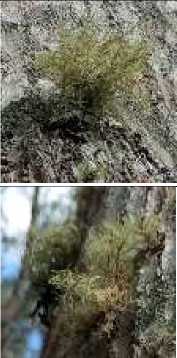
Fructicose
Fructicose
✓ Tree trunk
✓ Tree trunk
23 Pyxine subcinerea
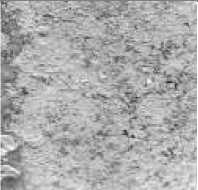
Foliose
✓ ✓ ✓ Tree trunk
24 Cryptothecia sp
25 Lepraria lobificans

crustose
crustose
✓ ✓
✓ Rock and tree trunk
✓ ✓ Rock and tree
trunk
26 Lepraria incana
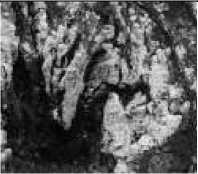
crustose
✓ ✓ Rock,
Weathered
Wood and tree trunk
27 Lepraria sp 1
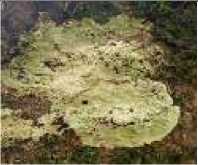
crustose
✓ Tree trunk
Spesies
No Family
Name
28 Ramalina farinaceae Ramalinaceae
Ficture
Station
Thallus Type 1 2 3
Substrate
29 Hydropunctaria maura Verrucariaceae
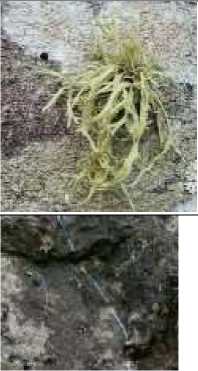
Fructicose
Crustose
✓ Tree trunk
✓
Rock
Discussion and feedback